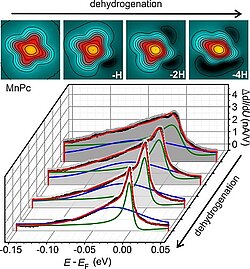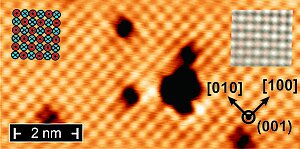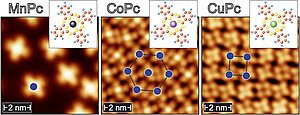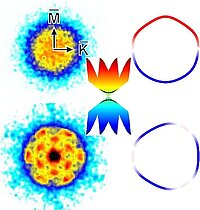2015
Image & Results Gallery (2015 archive)
State identification and tunable Kondo effect of MnPc on Ag(001)
August 16th
Lately intensive research has been carried out to investigate the electronic and magnetic properties of phthalocyanines. These organic molecules have a planar organic frame with a transition metal ion at the center and are traditionally used to dye textiles. More recently it has been discovered that they may also be potential candidates for future molecular electronic or spintronic devices. Especially the so-called Kondo effect, i.e., the collective screening of uncompensated spins by conduction electrons of the substrate, has been intensively investigated. Earlier studies showed a second satellite feature whose origin could not be conclusively clarified. We have studied intact and chemically modified molecules by scanning tunneling spectroscopy, density functional theory, and Monte-Carlo calculations. Our results reveal that the satellite feature is caused by the central transition metal ion's dz2 orbital which gradually shifts towards the Fermi level as hydrogen atoms are removed from the molecule. The result has been published in Phys. Rev. B.
Click image for full size view
Growth and magnetic domain structure of ultra-thin Fe-films on Rh(001)
June 16th
Iron (Fe) is the prototypical ferromagnet. Its latin name, ferrum, is even used as a prefix to describe ordered magnetic materials. However, Fe is also a good example for the consequences of allotropy, i.e., the ability to exist in different crystal structures. For example, face-centered cubic (fcc) Fe is known to be antiferromagnetic, while Fe in its usual body-centered cubic (bcc) crystal structure is ferromagnetic. In this publication we verify the antiferromagnetic ground state of an fcc Fe monolayer on Rhodium by imaging the spin orientation with atomic resolution (see image). Our results show that thicker Fe films are ferromagnetic and exhibit stripe domains with the magnetization alternatingly pointing up and down. The result has been published in Phys. Rev. B.
Click image for full size view
Systematics of Molecular Self-Assembled Networks at Topological Insulators Surfaces
May 21th
The success of topological insulators (TI) in creating devices with unique functionalities is directly connected to the ability of coupling their helical spin states to well-defined perturbations. With collaborators from the Russian Academy of Sciences in Novosibirsk, we demonstrated that molecular self-assembly processes offer the opportunity to create well-defined networks at TI surfaces. The symmetry of the overlayer can be finely controlled by appropriate chemical modifications. This approach offers a precise and fast way to produce tailor-made nanoscale surface landscapes. The result has been published in Nano Letters.
Click image for full size view
Signatures of Dirac fermion-mediated magnetic order
April 15th
Topological materials with their unusual spin structure offer an ideal platform to explore novel magnetoelectric effects. In cooperation with scientists from the Russian Academy of Sciences in Novosibirsk, we have investigated the influence of single magnetic atoms deposited on the topological insulator Bi2Te3. We obtain signatures of Dirac fermion-mediated magnetic order for extremely dilute adatom concentrations.
The result has been published in Nature Communications.
Click image for full size view









